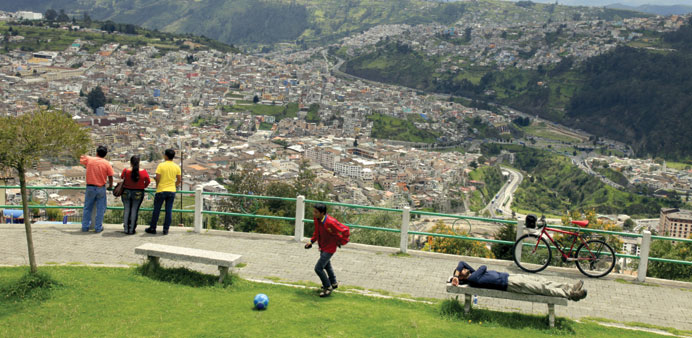By Bonnie James
Many things could go wrong on the first day of a new international airport, so it was a pleasant surprise when my flight landed on schedule at the new Mariscal Sucre International airport in Quito, the capital of Ecuador.
After flying for 20 hours (Doha-London Heathrow via Bahrain, 7 hours; London Heathrow-Miami, 9 hours; Miami-Quito, 4 hours) with a 10 hour transit (6 hours in London Heathrow and four in Miami) the last thing you want is any delay at the final destination.
The immigration process in Quito is simple and smooth. Just one small form to fill and Ecuador is one of the most lenient countries in the world in terms of immigration policy.
All foreigners, except nationals of 10 countries (Afghanistan, Bangladesh, China, Eritrea, Ethiopia, Kenya, Nepal, Nigeria, Pakistan, and Somalia) are permitted to stay up to 90 days without a visa. But to transit the US, one needs to get a visa in advance.
The clean, cool mountain air of Quito is a revitalising experience. You can breathe easy the moment the aircraft door opens — Quito is cradled by the Andes, the longest continental mountain range in the world, that extends from north to south through seven South American countries: Venezuela, Colombia, Ecuador, Peru, Bolivia, Chile and Argentina. Landing and take-off during the day from Quito are a treat for the eyes — the azure sky decorated with snowy white clouds and green mountains.
With two UN sustainability awards, and a brace of airport finance and structuring honours, Mariscal Sucre International, which boasts a 4.1km runway, the longest in South America, is at least an hour away from the city of Quito.
A majority of the tourists flying in to Quito, usually proceed to the immensely popular Galapagos Islands, which provided substantial inputs to Charles Darwin’s theory of evolution by natural selection.
Quito, formally San Francisco de Quito, is at an elevation of 9,350ft — described as the highest capital city in the world housing the administrative, legislative and judicial functions — so the altitude may bother you for a couple of days, especially if you are from a low-altitude country. For example, Qatar’s altitude is just 66ft.
Quito, spread across 324sqkm with a population of about 2mn, is a blend of colonial history and the modern. It was founded in 1534 on the ruins of an ancient Inca city. Quito was the first city to be named a Unesco World Heritage Site in 1978, along with Krakow in Poland.
Quito has one of the largest, least-altered and best-preserved historic centres in the Americas. The central square of Quito is located about 25km south of the equator and the city itself extends to within about 1km of zero latitude. Ecuador in Spanish means equator.
Because of its elevation and its proximity to the equator, Quito has a fairly constant cool climate. The average temperature at noon is 18.7°C with a normal night-time low of 9.3°C. The annual average temperature is 14.0°C. The city experiences only two seasons: dry and wet. The dry season, June through September, is referred to as summer; the wet season, October through May, is referred to as winter.
Given that the main agenda of my trip to Ecuador was a journey to the Yasuni National Park, the ‘biologically richest place on Earth’ there was very limited sightseeing in Quito, but what I saw was memorable.
• The Plaza Grande: Formally known as Plaza de la Independencia. The white building on the northwest side of the plaza with the national flag flying atop is the Presidential Palace.
• El Panecillo: The small hill to the south of the old town provides a splendid view of the whole city, as well as the surrounding volcanoes. At the very top is a 41m high aluminium statue of Virgin Mary (Virgin of Quito), erected in 1976 by Spanish artist Agustin de la Herran Matorras.
• Church of the Society of Jesus of Quito: A very interesting location for history, art and architecture enthusiasts. Built by Jesuit priests between 1605 and 1765, it is a marvellous sight to behold. A sublime golden hue envelops the interiors, featuring intricate artwork covered by fine 23-carat gold leaf.
• Otavalo and Cotacachi town market: Everything from home furnishings, food, clothing, meat, handicrafts and textiles, made in Ecuador Panama hats, fine leather goods, toys and more.

A panoramic view of Quito, as seen from El Panecillo.
